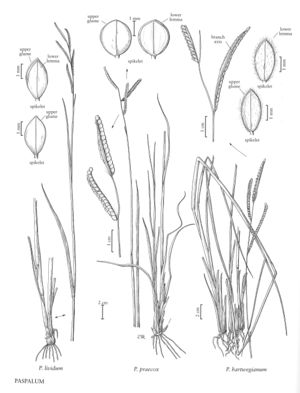Difference between revisions of "Paspalum hartwegianum"
FNA>Volume Importer |
FNA>Volume Importer |
||
| Line 17: | Line 17: | ||
-->{{Treatment/Body | -->{{Treatment/Body | ||
|distribution=Tex. | |distribution=Tex. | ||
| − | |discussion=<p | + | |discussion=<p>Paspalum hartwegianum grows in wet prairies, ditches, and swales from southern Texas through Mexico and Central America to Paraguay and Argentina.</p> |
|tables= | |tables= | ||
|references= | |references= | ||
| Line 33: | Line 33: | ||
|basionyms= | |basionyms= | ||
|family=Poaceae | |family=Poaceae | ||
| + | |illustrator=Linda A. Vorobik and Cindy Roché | ||
|distribution=Tex. | |distribution=Tex. | ||
|reference=None | |reference=None | ||
| Line 38: | Line 39: | ||
|publication year= | |publication year= | ||
|special status= | |special status= | ||
| − | |source xml=https:// | + | |source xml=https://bibilujan@bitbucket.org/aafc-mbb/fna-data-curation.git/src/314eb390f968962f596ae85f506b4b3db8683b1b/coarse_grained_fna_xml/V25/V25_1491.xml |
|subfamily=Poaceae subfam. Panicoideae | |subfamily=Poaceae subfam. Panicoideae | ||
|tribe=Poaceae tribe Paniceae | |tribe=Poaceae tribe Paniceae | ||
Revision as of 16:16, 30 October 2019
Plants perennial; decumbent or cespitose. Culms 50-120 cm, erect; nodes glabrous. Sheaths glabrous, sparsely pubescent apically; ligules 2-5 mm; blades to 21 cm long, 2-5 mm wide, flat, glabrous, pubescent behind the ligules, margins ciliate basally. Panicles terminal, with 4-9 racemosely arranged branches; branches 2-6.5 cm, divergent to erect, terminating in a spikelet; branch axes 1.2-1.5 mm wide, winged, glabrous, margins scabrous. Spikelets 2.8-3 mm long, 1.5-1.6 mm wide, paired, imbricate, appressed to divergent from the branch axes, elliptic, stramineous. Lower glumes absent; upper glumes and lower lemmas abundantly pubescent, hairs longer than 0.1 mm, 3-veined, margins entire; lower lemmas lacking ribs over the veins; upper florets 2.5-2.7 mm, white to stramineous. 2n = 60.
Discussion
Paspalum hartwegianum grows in wet prairies, ditches, and swales from southern Texas through Mexico and Central America to Paraguay and Argentina.
Selected References
None.
